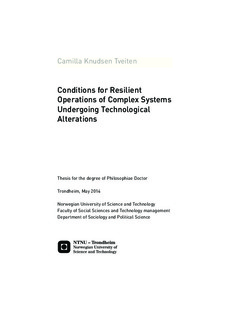| dc.contributor.author | Tveiten, Camilla Knudsen | nb_NO |
| dc.date.accessioned | 2014-12-19T14:36:56Z | |
| dc.date.available | 2014-12-19T14:36:56Z | |
| dc.date.created | 2014-07-24 | nb_NO |
| dc.date.issued | 2014 | nb_NO |
| dc.identifier | 743140 | nb_NO |
| dc.identifier.isbn | 978-82-326-0228-5 (printed ver.) | nb_NO |
| dc.identifier.isbn | 978-82-326-0229-2 (electronic ver.) | nb_NO |
| dc.identifier.uri | http://hdl.handle.net/11250/268902 | |
| dc.description.abstract | Technological alterations are ongoing in many areas, also in high-risk industries. The petroleum production industry in Norway is going through a technologicallydriven transition period named “Integrated Operations” (IO). The transition includes changes in sensor technology that increase the amount of data provided for important decisions, information and communication technology that enable the remote operation of offshore fields and distributed organizations, and possibilities for operations in marginal fields where oil and gas production was not previously possible. Transitions have been a part of petroleum operations for as long as the industry has existed in Norway – companies merge and new fields are developed. Whereas technological development has followed a continuous path, in other ways IO represents a change due to the dramatic impact it has on its dependence on the geographical location of the actors.
Outside IO there is a quite a dramatic change in the industry as we move towards the end of the petroleum age. Changing public opinion following accidents such as that in the Gulf of Mexico in 2010 as well as climate challenges represents a threat to expanding production.
The dissertation explores 1) the establishing of risk images in an early phase of the development of IO and how risks are differently comprehended in different groups of people, 2) how system risk models can be used to understand how risks may emerge in complex systems as IO, and 3) how emergency handling can benefit from a resilience perspective with IO. The results indicate that altered risk images are formed at an early stage of a (technological) development. Participation in different communities of knowing determines the comprehension of risks. Risk comprehension is influenced by technology optimism as well as one’s position in groups such as being part of the management or being responsible for implementation of new concepts or technology. I found that the industry still relied on traditional risk assessment, and that areas where the technological development will have great impact, such as in emergency management did not enter a significant transition period during the period of this study.
I have argued that IO is representative of the time in which it exists – not only something restricted to the oil and gas industry. The trends are not unique. Neither are some of the challenges identified for IO, especially when it comes to the comprehension and handling of risks. By that I find that the results from my work matter for the world outside IO – in healthcare, transport, energy, transport infrastructure, finance and telecommunications. | nb_NO |
| dc.language | eng | nb_NO |
| dc.publisher | Norges teknisk-naturvitenskapelige universitet, Fakultet for samfunnsvitenskap og teknologiledelse, Institutt for sosiologi og statsvitenskap | nb_NO |
| dc.relation.ispartofseries | Doktoravhandlinger ved NTNU, 1503-8181; 2014:153 | nb_NO |
| dc.relation.haspart | Tveiten, Camilla Knudsen; Schiefloe, Per Morten.
Risk images in a changing high-risk industry. Risk Management: An International Journal 2014 ;Volum 16.(1) s. 44-61 <a href="http://dx.doi.org/10.1057/rm.2014.3" target="_blank"> http://dx.doi.org/10.1057/rm.2014.3</a> | |
| dc.relation.haspart | Paper 2: Tveiten, Camilla Knudsen, Skogdalen, Jon Espen.
Safety perception and
comprehension among offshore
installation managers on the
Norwegian Continental Shelf | |
| dc.relation.haspart | Paper 3: Tveiten, Camilla Knudsen.
Resilient planning of modification
projects in high-risk systems: The
Implications of Using FRAM for
Risk Assessments.
Chapter in book: Eirik Albrechtsen and Besnard, Denis (eds) (2013) Oil and Gas,
Technology and Humans. Assessing the Human Factors of Technological Change.
Ashgate. | |
| dc.relation.haspart | Paper 4:
Tveiten, Camilla Knudsen; Albrechtsen, Eirik; Wærø, Irene; Wahl, Aud Marit.
Building resilience into emergency management. Safety Science 2012 ;Volum 50.(10) s. 1960-1966
<a href="http://dx.doi.org/10.1016/j.ssci.2012.03.001" target="_blank"> http://dx.doi.org/10.1016/j.ssci.2012.03.001</a> | |
| dc.title | Conditions for Resilient Operations of Complex Systems Undergoing Technological Alterations | nb_NO |
| dc.type | Doctoral thesis | nb_NO |
| dc.contributor.department | Norges teknisk-naturvitenskapelige universitet, Fakultet for samfunnsvitenskap og teknologiledelse, Institutt for sosiologi og statsvitenskap | nb_NO |
| dc.description.degree | PhD i sosiologi | nb_NO |
| dc.description.degree | PhD in Sociology | en_GB |
